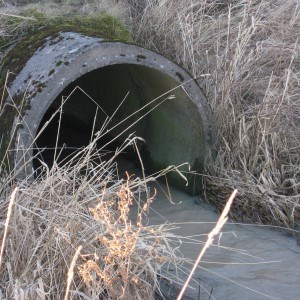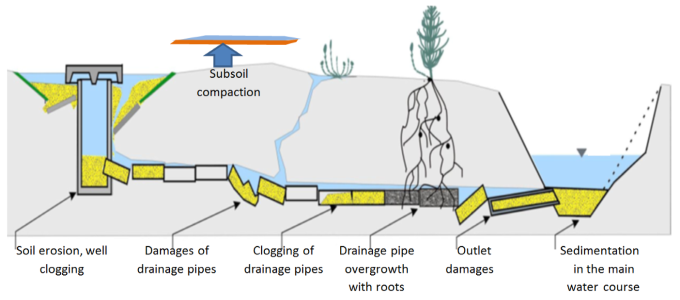Renovation of drainage systems

Drainage systems in agricultural land are implemented to secure optimal water balance in the soil for agricultural production. To keep the function of the drainage systems over time, maintenance and renovation is required.
Surface and subsurface drainage systems are needed to collect and remove standing or excess water from agricultural fields, especially during spring time for soil preparation, sowing, and fertilizer application purposes, vegetation season to secure healthy agricultural crop development and late autumn for harvesting purposes. Over the exploitation time malfunctioning of drainage systems could appear thus leading to increased groundwater level, restricted field operations, and failure in crop growth. Therefore, the maintenance and renovation of drainage systems is suggested.
Localisation and implementation
First step to identify failures in agricultural drainage systems is to inspect overall functioning and condition of the main water course (channel or ditch), where water from subsurface drainage systems is discharged. Prior any practical work, the status and ownership of a specific water course must be identified and legal requirements for planning and implementation activities have to be studied. If the main water course is covered by vegetation, i.e., grass, shrubs, small trees, it is likely that the bottom section of this water course has been filled with sediments over time often leaving drain collector outlets buried under a layer of sediments.
Second step is to localize drain collector outlets to mark those accordingly in order to avoid potential damages during excavation work. In case of necessity of excavation work it is suggested to perform mechanical cleaning activities in the water course during the summer low flow season starting from the downstream segments of the water course and continuing in the upstream direction. Once the drain collector outlets are found and repaired, those also should be protected, for example with concrete lining or rip-rap stones underneath to exclude risks of soil erosion from the embankment (Figure 1).

Effects, duration and maintenance
To improve performance efficiency of drainage systems surface water inlets if present should be inspected and cleaned every year. In case of problems with clogging in subsurface drainage systems caused by sedimentation or chemical deposition rinsing machinery should be used.

Renovation of drainage systems - extended description
Renovation of drainage systems - links to resources
Author and contact:
Kaspars Abramenko, Latvia University of Life Science and Technologies (LLU), Latvia. e-mail

